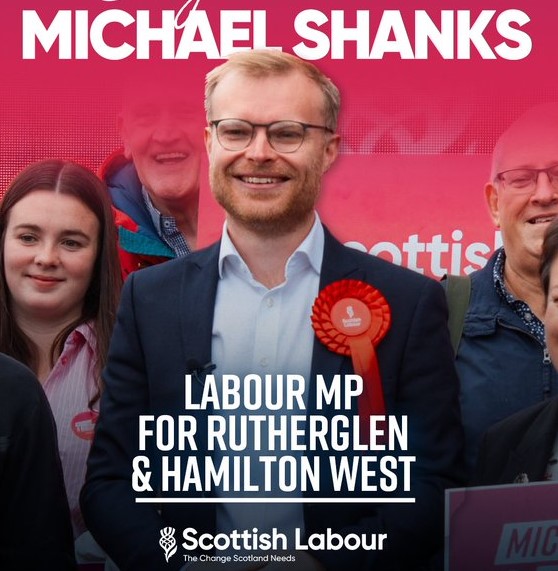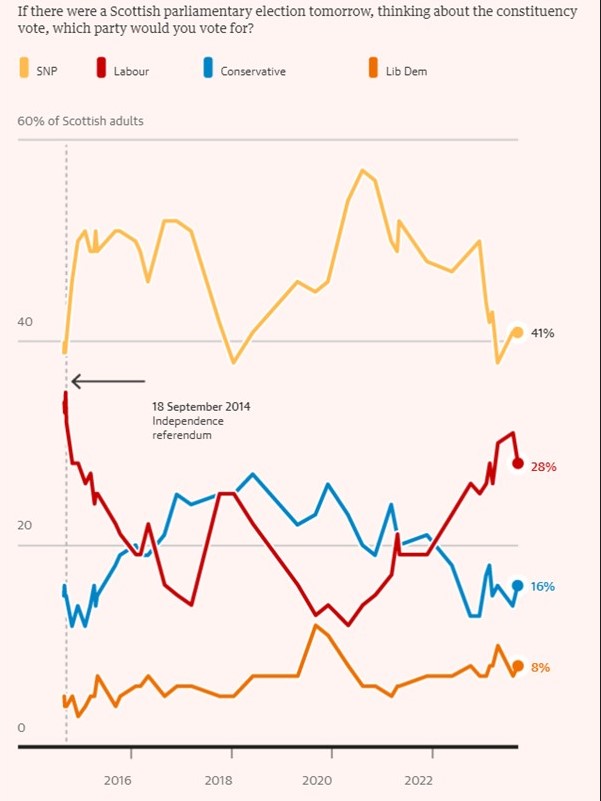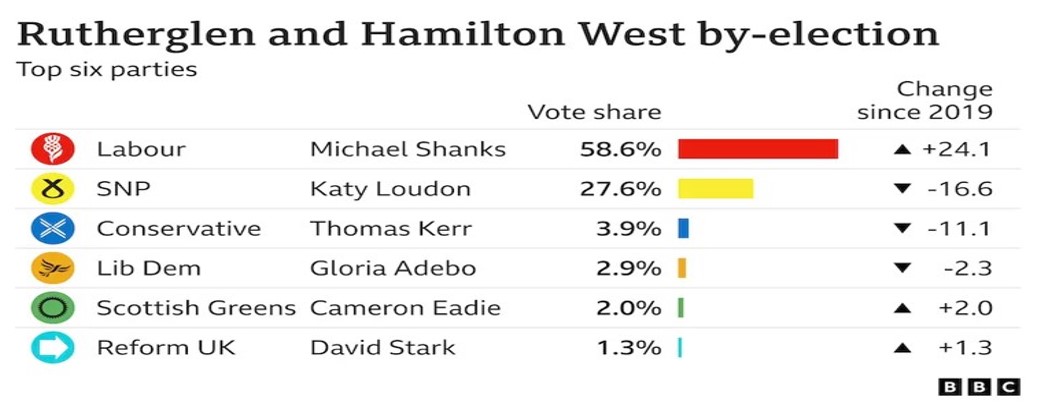By Gray Allan, Falkirk Labour Party member
Now that the media circus has moved on, it is time to take a sober look at the meaning of the by-election result in Rutherglen and Hamilton West. While Scottish labour’s victory had been expected, the size of the win took everyone, including the Party, by surprise. Mainstream and social media are full of superlatives, like “seismic” “thunderbolt” and “resounding”. But was it really?
On a dreich day in West Central Scotland, with plenty of wind and rain, only 37% of voters turned out to cast their vote. This was also the first Westminster election in Scotland where voter ID was needed. Michael Shanks, the Labour candidate, took 17,845 votes or 58%, up by 24.1 points since the General Election in December 2019.
The SNP candidate, Katy Loudon, got 8,399 votes, or 28%, dropping by 16.6 points. This was a must-win seat for Scottish Labour and a 5% swing from the SNP to Labour would have secured a victory. Swings from SNP to Labour in recent council by-elections of 5%-plus bolstered the Party’s confidence.
Undoubtedly there was some Tory to Labour tactical voting. Some scunnered SNP voters stayed at home, but even if they had all turned out, the SNP would not have won, given the size of the swing to Labour. SNP stay-at-homes do not explain the size of the swing.
Many families are struggling with real poverty
Activists were being told on the doorsteps that while support for Independence was still high, it was not seen as a high priority. It has been relegated to the status of a nice idea to be pursued sometime in the indeterminate future. The burning issue for voters is the cost-of-living crisis. Many are struggling, with some in real poverty.

Keir Starmer and Anas Sarwar are predictably presenting this win as the start of Labour’s comeback in Scotland. On the basis of this swing Professor John Curtice is predicting Labour would pick up over forty seats in Scotland at the next general election.
But this is overly optimistic. It ignores the local factors, like Margaret Ferrier MP’s conviction for breaching COVID regulations, and the marginality of the Rutherglen constituency. It is also hard to draw wider conclusions from a by-election with a turn-out of 37%. Somewhere around a twenty-five seat Labour gain would be a more realistic target
The Scottish Labour campaign also dwarfed that of the SNP. Hundreds of Labour activists hit the doors with 150 out on polling day alone. It seemed to me that the Burnside campaign HQ was staffed by full-timers from across the UK. One new full-timer with whom I was canvassing admitted that in his first four months with the Party his entire time had been spent in Rutherglen!
The SNP failed to mobilise its base
Keir Starmer made several visits and Labour front benchers and former Prime Ministers Gordon Brown, was there. This same effort could not not be repeated in the upcoming general election campaign.
By way of contrast, the SNP failed to mobilise its activist base. At one point in the campaign, they had to hire a courier company to deliver campaign leaflets. Nationalist sources in the constituency cited deep dissatisfaction with the way they felt that Margaret Ferrier had been “hung out to dry” by Nicola Sturgeon and Humza Yousaf. Ferrier had been seen as a very effective local MP and a tireless campaigner.
Deeply unpleasant internal divisions over the gender recognition issue, an “anti-woke” tendency and real hostility to the link with the Greens have sapped the enthusiasm of the SNP rank and file. The Alba Party openly calls on the SNP to kick the Greens out of the Scottish Government.
The result is not like hitting the ‘re-set’ button in Scottish politics as some commentators have suggested. It does, however, have possible serious consequences for the SNP. Leader, Humza Yousaf, has said that his Party “needs to reflect on what we can do to regain the trust of the people”. Which is exactly what Anas Sarwar Leader of Scottish Labour was saying a few months ago! And The SNP have a lot to reflect on.
Bruising contest for the SNP leadership
Yousaf’s grip on power inside the SNP is weak. He recently won a bruising leadership election with 48% of the first preference votes compared to his nearest rival Kate Forbes who got 41% of first preference votes. He faces his first SNP Conference as leader with big questions to deal with, like infrastructure projects which are in crisis, such as the plan for dualling the A9 trunk road from Perth to Inverness. There is a fiasco in the procurement for the contract to build two new hybrid power ferries for the state-owned operator Caledonian Macbrayne. There is the crisis in public services with the chronic under-funding of local government.

All this is without touching on the continuing police investigation into SNP finances, which saw both Nicola Sturgeon and her husband Peter Murrell being arrested and then released pending further enquiries. This enquiry centres on the disappearance of over £600,000 collected by appeal for funds to support the campaign for IndyRef2, a second independence referendum. The disappearance of six hundred grand appears to coincide with the appearance of a luxury motor home in Murrell’s mother’s driveway! All of which have served to make the SNP a bit of a laughing stock.
The SNP have been in power at Holyrood for sixteen years. Party discipline for most of that time has been remarkable, with the Cause binding the disparate factions together. Time, however, takes its toll. Events build up and the tally of miss-steps and miscalculations mount.
There is no clear and agreed route to a second referendum and independence. Nationalists fragment, aligning with different strategies to further the Cause. Yousaf and the current leadership support the de facto referendum strategy, treating the next general election as a ‘referendum on independence’ with negotiations on separation beginning immediately after polling day, assuming the SNP win a majority in Scotland.
Smaller nationalist groups not picking up on SNP decline
Fundamentalists call for an immediate Catalonia-style referendum, without permission from Westminster. And a new formation including SALVO, Liberation and the Scottish National Congress Steering Committee, will seek an International Court of Justice ruling via the UN, to overturn the 1707 Act of Union. Just what would happen if the ICJ did overturn the Act of Union is not explained
The SNP still dominates the ‘Yes’ movement but rumblings of dissent, both internally and externally, are growing. Alex Salmond’s Alba, which did not stand in the Rutherglen by-election, calls for a united front of all nationalist parties. A splinter group, The Independence for Scotland Party, which opposes the SNP’s policy of rejoining the European Union, did stand but got only 207 votes. All Under One Banner (AUOB) continues with demonstrations supporting independence. The saltire flags and Catalonian banners still fill the streets but the numbers attending are down.

The SNP will be holding its annual conference in Aberdeen later in October. It remains to be seen if there will be any challenge to Humza Yousaf’s strategy. Or indeed, how much reflection on the state of Scotland’s governing Party will take place. While support for independence sticks at around 47%, the support for the SNP has slipped to 38%. Other nationalist parties have so far not benefited from this slump in support for the SNP. On the evidence of Rutherglen this has gone straight back to Labour.
The key to developments in Scotland lie in England, as they often do. The SNP’s most persuasive argument for independence is to free Scotland from Tory rule. They have a real problem when there is a good chance that Labour will win a general election.
As an aside, the Scottish Socialist Party and the Scottish Trade Union and Socialist Coalition both stood candidates but only got 271 and 178 votes respectively, 1% of the vote each. If these groups were active at all, they were swamped by the Labour machine.
Labour is not yet returning to its pre-2014 position
Inevitably, Scottish Labour and the UK Party are making the most of the result. It is being hailed as a political earthquake; a soundbite, ironically, that Alex Salmond was fond of using. But Labour is in danger over-egging the pudding. It is a very good result, but does not mean that Labour is returning to its position pre-2014. However, even a more modest swing compared to that of Rutherglen, if repeated throughout Scotland, could mean Labour returns enough Scottish MPs to help secure a Labour majority government at Westminster.
Independence is no longer the top priority for voters in Scotland but it still enjoys 47% support. Scottish Labour must have something more substantial to say on a second referendum other than “now is not the time”
As regards, Labour’s policy on abolition of the House of Lords, Professor James Mitchell of Edinburgh University has argued that Labour must have a radical programme, for example to replace the Lords with a Senate of the regions and nations, which will prevent Scotland from being cut out of real decision making, regardless of which party is in power at Westminster.
But that leaves out of account the simple issue of the right of Scotland, if it so wishes, to become independent. If the SNP has a majority in the Scottish Parliament, Labour should not block its right to call for another referendum. Labour’s biggest danger is that it simply doubles down on its unionist and anti-SNP rhetoric. Given that Labour will need to win back working-class voters who moved to the SNP, this is a real risk.
But for most voters, the consitutional issues are secondary. Labour must commit to taking action on the issues raised time and time again on the doorsteps in Rutherglen: rising prices, rents and mortgages, all of which are leaving people in real poverty. Public services are weak or have had to be withdrawn due to austerity.
Unfortunately, with Keir Starmer leading the Party, restoration of services and policies that offer meaningful improvements in living standards will not happen automatically. It will need the campaigns of socialists in the Party, for their voices to be loud and to demand action.



